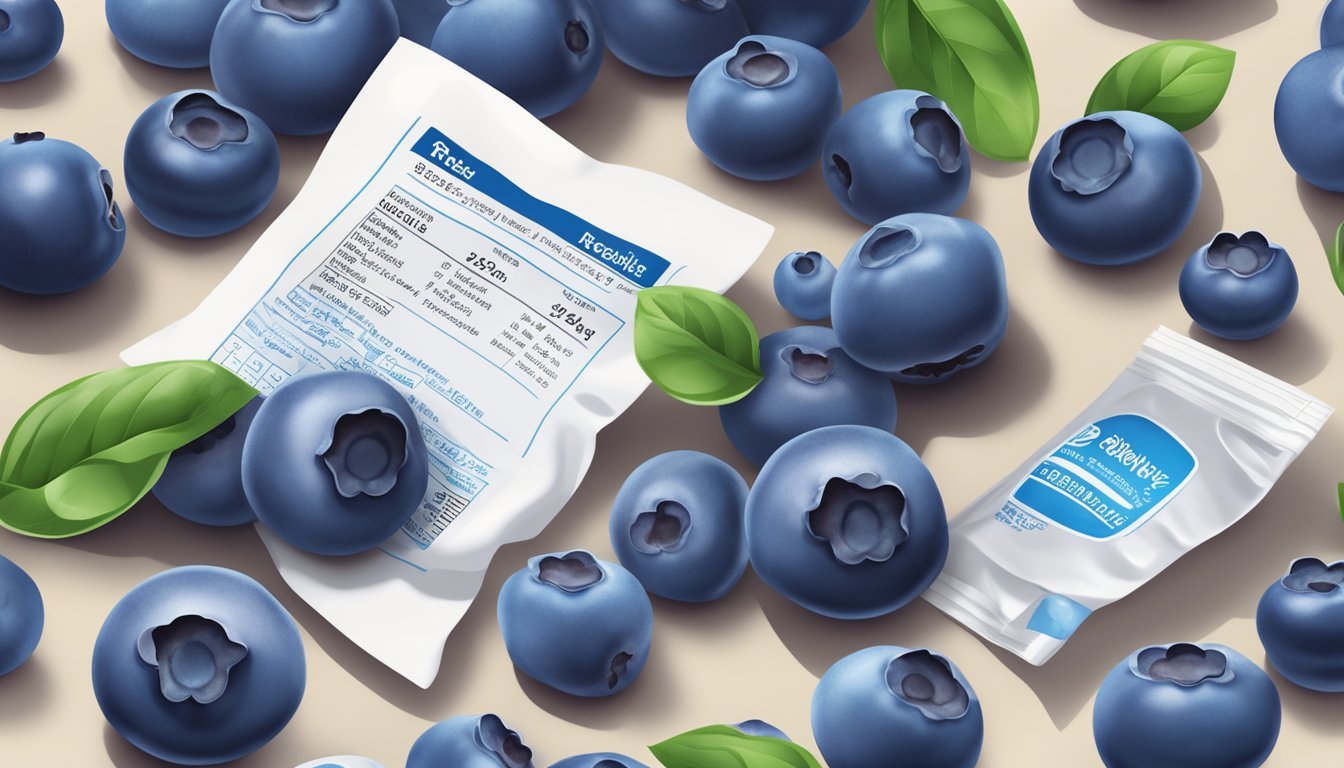Fresh vs. Frozen Blueberries: Which Makes the Perfect Pie?
Blueberry pie is a beloved dessert that captures the essence of summer in every bite. When it comes to making this classic treat, bakers often debate whether to use fresh or frozen blueberries. Both options have their merits and can produce delicious results.
Fresh blueberries offer vibrant flavor and texture, while frozen berries provide year-round availability and convenience. Fresh berries straight from the bush or farmers market burst with juicy sweetness and maintain their shape well during baking. Frozen blueberries, on the other hand, are picked at peak ripeness and can be just as flavorful when properly thawed and prepared.
The choice between fresh and frozen blueberries often comes down to personal preference, seasonal availability, and recipe requirements. Some bakers prefer the consistency of frozen berries for pie filling, while others swear by the bright taste of fresh fruit. Ultimately, both can yield a mouthwatering blueberry pie that will delight family and friends.
The Benefits of Fresh Blueberries
Fresh blueberries offer distinct advantages for pie-making, particularly in terms of flavor and nutritional value. Their natural sweetness and vibrant color can enhance the overall quality of a homemade pie.
Nutrient Profile and Flavor
Fresh blueberries are packed with essential nutrients. They contain high levels of antioxidants, vitamin C, and dietary fiber. These berries provide a good source of manganese and vitamin K as well. Their natural sweetness and slightly tart flavor profile shine in pies, offering a burst of authentic taste.
Fresh blueberries have a firm texture that holds up well during baking. This texture contributes to a pleasing mouthfeel in the finished pie. The berries' natural juices release during cooking, creating a rich, flavorful filling.
Peak Ripeness and Seasonal Availability
Fresh blueberries are at their best when harvested at peak ripeness. This ensures optimal flavor, sweetness, and nutritional content. During the summer months, fresh blueberries are readily available in many regions.
Seasonal availability allows bakers to take advantage of locally grown berries. These fresh-picked blueberries often have superior flavor compared to those that have traveled long distances. Using in-season blueberries can result in a more vibrant and flavorful pie filling.
The natural juiciness of fresh blueberries can contribute to a perfectly balanced pie texture. When baked, they release their juices gradually, creating a thick, jammy consistency that is ideal for pie fillings.
Understanding Frozen Blueberries
Frozen blueberries offer a convenient alternative to fresh berries for pie-making. They provide year-round availability and retain much of their nutritional value through the freezing process.
Freezing Process and Nutrition
Frozen blueberries are typically flash-frozen at peak ripeness. This quick freezing method helps preserve the berries' nutritional content. Frozen blueberries retain high levels of antioxidants, vitamins, and minerals.
The freezing process does not significantly impact the fiber or protein content of blueberries. In fact, frozen blueberries can sometimes have higher nutrient levels than fresh ones that have been stored for extended periods.
When thawed, frozen blueberries may release more juice than fresh berries. This extra moisture can affect pie texture, but bakers can adjust recipes to account for it.
Convenience and Year-Round Accessibility
Frozen blueberries offer unmatched convenience for pie-making. They eliminate the need for washing and sorting, saving time in the kitchen. Their long shelf life in the freezer reduces food waste.
Frozen berries allow bakers to enjoy blueberry pies year-round, regardless of the growing season. This accessibility makes it possible to create delicious pies even when fresh blueberries are scarce or expensive.
For best results, thaw frozen blueberries before use in pies. This step helps control moisture content and ensures even baking. Some recipes may require additional thickeners to achieve the desired pie filling consistency.
Comparing Fresh and Frozen Blueberries for Pies
Fresh and frozen blueberries each offer distinct advantages for pie-making. The choice between them impacts flavor, texture, and preparation methods.
Taste and Texture Considerations
Fresh blueberries provide a burst of bright, juicy flavor in pies. Their firm texture holds up well during baking, creating distinct berry pieces in the filling. Frozen blueberries often have a slightly muted taste compared to fresh ones.
When thawed, frozen berries release more juice, which can make fillings softer. This extra moisture can be beneficial for achieving a jammy consistency. Some bakers prefer using a mix of fresh and frozen berries to balance flavor and texture.
Frozen blueberries may require additional sweetener or lemon juice to enhance their flavor profile. Fresh berries typically need less sugar, allowing their natural sweetness to shine through.
Impact on Pie Filling Consistency
Fresh blueberries tend to hold their shape better during baking. This results in a chunkier filling with more defined fruit pieces. Frozen berries break down more easily, creating a smoother, more uniform filling texture.
To manage excess liquid from frozen berries, bakers often increase the amount of thickener used. Common options include:
Cornstarch
Tapioca starch
All-purpose flour
Fresh berries require less thickener, which can lead to a cleaner berry flavor. Frozen berries may need up to 1-2 tablespoons more thickener per cup of fruit to achieve the desired consistency.
Preheating frozen berries with sugar and cornstarch before adding them to the pie can help control moisture levels. This step isn't necessary with fresh berries.
Availability and Cost Implications
Fresh blueberries are seasonal and more expensive outside their peak growing months. Their limited availability can make consistent pie production challenging year-round. Frozen blueberries offer a more stable supply and consistent pricing throughout the year.
Buying fresh blueberries in bulk during peak season and freezing them at home can be cost-effective. This approach combines the quality of fresh berries with the convenience of frozen ones.
Frozen blueberries have a longer shelf life, reducing waste and allowing for spontaneous pie-making. Fresh berries must be used quickly to prevent spoilage, which can increase costs if not managed properly.
For commercial bakeries, frozen berries provide better inventory control and predictable ingredient costs. Home bakers might prefer fresh berries when available for their superior flavor and texture.
Baking the Perfect Blueberry Pie
Creating a delicious blueberry pie requires attention to three key elements: the crust, the berries, and the baking process. Each component plays a crucial role in achieving a flavorful, well-balanced pie.
Selecting the Right Crust
A flaky pie crust forms the foundation of an exceptional blueberry pie. Many bakers prefer a homemade pie crust for its superior texture and flavor. To achieve a flaky crust, use cold butter and work quickly to prevent overheating the dough.
For a 9-inch double-crust pie, prepare enough dough for both the bottom and top layers. Some recipes call for a lattice top, which allows steam to escape and creates an attractive appearance.
Before baking, apply an egg wash to the top crust. This gives the pie a golden-brown sheen and helps seal the edges.
Preparing Your Blueberries for Baking
Fresh or frozen blueberries can be used for pie filling. If using frozen berries, there's no need to thaw them first. Mix the berries with sugar, cornstarch, lemon juice, and spices like cinnamon.
For 6 cups of blueberries, use about 1 cup of sugar and 6 tablespoons of cornstarch. The cornstarch helps thicken the filling as it bakes.
Add a pinch of salt and some lemon zest to enhance the blueberry flavor. Gently mix the ingredients to avoid crushing the berries.
Adjustments in Baking Time and Techniques
Preheat the oven to 400°F (205°C) for the initial baking phase. Place the pie on a baking sheet to catch any overflow.
Bake for 30 minutes at this high temperature to set the crust. Then reduce the heat to 375°F (190°C) and continue baking for 30-45 minutes.
The pie is done when the crust is golden brown and the filling is bubbling. If the edges brown too quickly, cover them with aluminum foil.
Let the pie cool for at least 2 hours before serving. This allows the filling to set properly.
Customizing Your Blueberry Pie
Blueberry pies offer endless possibilities for personalization. From adding complementary flavors to making healthier adjustments, there are many ways to create a unique and delicious dessert.
Incorporating Additional Flavors and Toppings
Enhance your blueberry pie with complementary flavors. Add a splash of lemon juice to brighten the filling. Sprinkle cinnamon into the mixture for warmth and depth. For a citrusy twist, incorporate orange zest.
Consider topping your pie with whipped cream or vanilla ice cream. These classic additions provide a creamy contrast to the tartness of the berries. For added texture, sprinkle turbinado sugar on the crust before baking.
Try mixing in other berries like raspberries or blackberries for a mixed berry pie. Experiment with different sweeteners such as brown sugar or maple syrup to create unique flavor profiles.
Dietary Adjustments for Healthier Options
Make your blueberry pie more nutritious with simple substitutions. Use whole wheat flour in the crust for added fiber. Replace some of the granulated sugar with natural sweeteners like honey or stevia.
Reduce saturated fat by using unsaturated oils instead of butter in the crust. For a lower-cholesterol option, try an egg-free crust recipe. Decrease sodium content by limiting added salt.
Create a crustless blueberry pie for a lighter dessert. Layer the filling with Greek yogurt for added protein. For a gluten-free version, use almond flour or a gluten-free flour blend in the crust.
Consider using fresh blueberries when in season for maximum nutritional benefits. If using frozen, choose varieties without added sugars or preservatives.
Pie Presentation and Serving Suggestions
A beautifully presented blueberry pie enhances the dining experience. Proper preparation and serving techniques showcase the pie's appearance and flavor.
Achieving the Perfect Pie Lattice
A lattice crust adds visual appeal to blueberry pies. Start by rolling out the top crust and cutting it into even strips. Lay half the strips parallel across the filled pie. Fold back alternate strips and place a perpendicular strip across. Repeat, weaving the strips over and under.
For a tighter weave, use thinner strips spaced closer together. A looser lattice with wider gaps allows more filling to show through. Brush the lattice with egg wash for a golden sheen.
Crimp the edges by pinching the dough between thumb and forefinger. This seals the lattice to the bottom crust and creates a decorative border.
Serving Pie at Events and Gatherings
Blueberry pie makes an excellent dessert for events. Serve it slightly warm or at room temperature for the best flavor and texture. A dollop of vanilla ice cream or whipped cream complements the fruit filling.
Pre-slice the pie for easier serving at large gatherings. Use a sharp knife and wipe it clean between cuts for neat slices. Place each slice on a dessert plate with a fork.
For a buffet-style service, provide a pie server and plates nearby. Keep the pie covered until ready to serve to maintain freshness. Offer small plates and forks for guests to serve themselves.
Consider individual mini pies for a unique presentation at parties or weddings. These single-serving desserts are easy to distribute and reduce the need for cutting and plating.
Storing and Preserving Blueberry Pie
Proper storage techniques are crucial for maintaining the quality and safety of blueberry pies. Whether using fresh or frozen berries, these methods help preserve flavor and texture.
Refrigeration and Freezing Techniques
Refrigerate baked blueberry pies within two hours of cooling to room temperature. Cover loosely with plastic wrap or aluminum foil. Consume refrigerated pies within 3-4 days for best quality.
For longer storage, freeze whole pies or individual slices. Wrap cooled pies tightly in plastic wrap, then aluminum foil. Label with the date and freeze for up to 6 months.
To freeze unbaked pies, assemble as usual but don't apply egg wash or cut vents. Wrap tightly and freeze. When ready to bake, don't thaw - place frozen pie directly in preheated oven and add 15-20 minutes to baking time.
Maintaining Freshness for Make-Ahead Pies
For make-ahead pies, prepare filling and crust separately. Store filling in an airtight container in the refrigerator for up to 3 days. Wrap unbaked crust tightly and refrigerate for 2 days or freeze for up to 3 months.
Assemble and bake pie the day before serving for optimal freshness. Cool completely before storing in the refrigerator overnight. Bring to room temperature 30 minutes before serving.
To reheat, place pie in a 350°F (175°C) oven for 15-20 minutes. Cover edges with foil if browning too quickly. Serve warm or at room temperature for best flavor and texture.
Complementary Recipes and Ideas
Blueberry pie pairs wonderfully with various sides and desserts. Explore delicious accompaniments and alternative blueberry treats to enhance your culinary experience.
Sides and Accompaniments for Blueberry Pie
Vanilla ice cream is a classic companion to blueberry pie. Its creamy sweetness balances the tartness of the berries. Whipped cream offers a lighter option, adding a touch of indulgence.
For a twist, try lemon sorbet. Its citrusy flavor complements the blueberries beautifully. A dollop of crème fraîche provides a tangy contrast to the sweet pie.
Cheese pairings can elevate the dessert experience. Serve a slice of sharp cheddar or creamy brie alongside the pie for a savory-sweet combination.
For breakfast, pair blueberry pie with a cup of strong coffee or Earl Grey tea. The bold flavors of these beverages cut through the sweetness of the pie.
Other Desirable Blueberry Desserts
Blueberry muffins are a popular breakfast treat. Fold fresh or frozen blueberries into the batter for bursts of flavor. Blueberry scones offer a more refined option, perfect for afternoon tea.
Blueberry pancakes make a delightful weekend breakfast. Top with maple syrup and extra berries for a indulgent meal. For a rustic dessert, try blueberry cobbler. Its crumbly topping provides a satisfying texture contrast.
Blueberry shortcake offers a lighter alternative to pie. Layer biscuits with whipped cream and macerated blueberries. For a elegant dessert, make blueberry galette. This free-form tart showcases the berries beautifully.
Blueberry cake is versatile and can be served as a dessert or snack. Add lemon zest to the batter for extra flavor.
Nutritional Information and Health Aspects
Blueberries, whether fresh or frozen, offer similar nutritional profiles and health benefits. Both forms provide essential vitamins, minerals, and antioxidants that support overall wellbeing.
Caloric and Macronutrient Breakdown
A cup of blueberries contains approximately 84 calories. This serving size provides 3.6 grams of fiber, contributing to digestive health and feelings of fullness. Blueberries are low in protein and fat, with less than 1 gram of each per cup.
Carbohydrates make up the majority of blueberries' macronutrient content, with about 21 grams per cup. These carbs are primarily natural sugars and fiber. Blueberries contain no cholesterol and only trace amounts of sodium.
Blueberries are rich in vitamin C, offering 16-19% of the daily recommended intake per cup. They also provide significant amounts of vitamin K and manganese. The berries' deep blue color comes from anthocyanins, powerful antioxidants that may help protect cells from damage.
Fresh and frozen blueberries have comparable nutrient levels. Freezing can preserve nutrients effectively, making frozen berries a convenient year-round option without sacrificing nutritional value.









